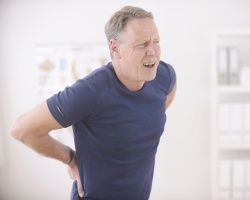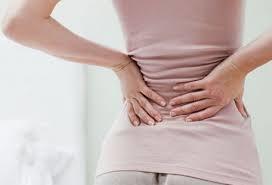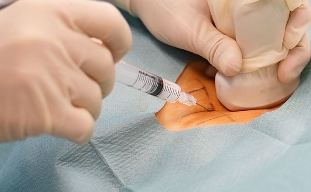Back pain is a symptom of the disease, which are often the muscles of the back and spine. In this article we will look at why back pain.
The problem in the low back can result from diseases of the bone tissue of the spine, the lumbar discs between the vertebrae, ligaments around the spine and discs, spinal cord and nerves, muscles of the low back, internal organs of the pelvis and abdomen and the skin covering the lumbar area. The upper part of the back can be painful, due to disease of the aorta, breast tumors or inflammation of the spine.

A sudden short pain in the lower back also called lumbago, and gradually developed chronic lumbalgia. If it hurts the lower back (the coccyx) is coccygodynia.
Causes of back pain
In most cases, back pain due to musculoskeletal disorders (microdamages of the joints and ligaments of the spine after heavy loads on them, tension or spasm of muscles). Some of the less common cause of pain to become more pronounced changes in the spine, such as herniated discs or displacement of the vertebrae (spondylolisthesis). Finally, in rare cases, back pain may be associated with serious diseases (tumors and inflammatory processes in the spine and spinal cord, diseases of internal organs — kidneys, heart, pancreas, pelvic organs, etc).
Possible causes for pain in the back
- Muscle cramps;
- A sprain (ligament injury );
- Muscle injury;
- Pregnancy;
- Scoliosis;
- Bleeding in the pelvis;
- Dissection of the aorta;
- Inflammation of the spine and pelvis;
- Lumbar spine stenosis;
- Metastases in the spine (cancer that has spread to the spine from other organs);
- Viral infections, including the flu.
The disease, which pain in the back
- Osteochondrosis;
- Abdominal aortic aneurysm;
- Ankylosing spondylitis;
- Bone cancer;
- Coccygodynia;
- Degenerative diseases of the vertebrae and disks;
- Diffuse idiopathic skeletal hyperostosis;
- Endometriosis;
- Fibromyalgia;
- Fracture;
- Kidney stones;
- Arthritis;
- Paget's disease;
- Pancreatitis, pancreatic cancer (girdle pain);
- Psoriatic arthritis;
- Reactive arthritis;
- Sciatica;
- Herpes zoster (pain and a characteristic rash on the skin).
What is the danger for back pain
Typically, back pain is of a permanent nature, aggravated by movement and physical exertion and are complete with reduced mobility in the spine and the feeling of stiffness in the back. In most cases, characterized by a relapsing course, in which episodes of exacerbations, usually elicit an intense physical activity, long-term presence in an awkward position, or hypothermia, are replaced with more or less long period of time in which pain is absent or minimally expressed.

In most cases of back pain do not represent a direct danger for the life and health of people, and often pass on their own (without treatment). However, sometimes back pain may be due to serious diseases of the spine or the internal organs.
The following features of back pain that can be associated with severe pathology. If you have any of these symptoms, you should immediately consult a doctor and in any case not to self-heal.
- Back pain is constant and localized in one place.
- Back pain is not reduced in the position of lying down, or occurs at night.
- Back pain accompanied by fever.
- Back pain accompanied by muscle tension of the limbs or in combination with long-term stiffness in the morning.
The diagnosis of back pain
- Examination by a neurologist to assess the state of the nervous system, muscles and the spine.
- General analysis of blood and urine tests to exclude inflammation of the kidneys.
- Spinal radiography to exclude osteomyelitis, fractures and other diseases. For clarification identified from the x-rays changes, the doctor may additionally request a CT or MRI of the spine (the first allows us to assess the status of the bone structure, the other — the spinal cord and intervertebral discs).
Very often, when these studies show degenerative changes in the intervertebral discs and vertebral bodies and makes a diagnosis of "osteochondrosis". It should be noted that the degenerative disc disease itself is not a disease, and reflects the age-related changes of the spine. Some of the changes in the intervertebral discs (including hernia), shows almost all people of Mature age, including never experienced back pain. In other words, identifying the signs of osteoarthritis on x-rays or a disc herniation in magnetic resonance imaging does not give us reason to believe that the back pain associated with them (such a decision can only doctor on the basis of the results of a clinical examination).
The treatment of back pain
To fully recover from back pain, they often do not succeed, however, you can reduce the frequency of exacerbations with the appropriate lifestyle and treatment with medications. Treatment of back pain depends on the cause for their appearance. Choose the treatment that suits You can be a doctor.
The effect of therapeutic interventions may take some time, so you will need patience and endurance. The main goal of treatment is not only to relieve the acute pain, but also in the prevention of the deterioration of the disease in the future.
How to relieve back pain
Bed rest can contribute to the transition of acute pain in the back chronic. With this in mind, when moderate pain is not necessary in bed, and when the intense pain, would it be possible to limit its duration (1-3 days).
If pain in the back, it should be limited at this time physical activity, in particular, avoid heavy lifting and prolonged stay in one position; it is important to do the movement without increasing the load on the spine.
Explains the spine and the rest of it is advisable to use a special belt or corset.

Cure for back pain
Treatment depends on the cause of pain in the back and set by your doctor after the examination.
For pain relief using nonsteroidal anti-inflammatory drugs, manufactured in the form of tablets, ampoules forms for injections, creams and gels and pain medications or combinations of medications. Drugs in both groups the prescribed short period of time (usually 3-5 days). In addition, to eliminate the pain, apply compresses with a solution of local anesthetics and pharmacological blockade (which may only be undertaken by a doctor).
The pain associated with muscle tension and the use of medications to eliminate the muscle spasm (muscle relaxants of Central action in 1-2 weeks). Take this medicine only on prescription.
Currently, for the treatment of back pain associated with degenerative changes of the spine (osteochondrosis), I suggest you to use special drugs — drugs that stimulate the production of the main components of cartilage tissue and thus prevents their destruction. The effectiveness of these drugs in diseases of the spine is not demonstrated, the same can be said about many of the often advertised supplements (usually containing medicinal plants, biological products, vitamins, etc) and homeopathic remedies. Despite the fact that all these tools are freely dispensed in pharmacies without a prescription, do not take them without consulting with your doctor first.
Physiotherapy and exercise therapy for back pain
In order to reduce the severity of the pain can be used dry heat (not deep heat), and other physiotherapy treatments, but only after consulting with your doctor first.
After the end of the acute period of useful therapeutic exercise for special complexes (strengthens the back muscles and abdomen) and massage.
Chiropractic for back pain
Manual therapy may be prescribed only the doctor, after the execution of the radiography and/or magnetic resonance imaging, which allow the objective assessment of the status of the spine and its surrounding tissues. With proper implementation of manual therapy (the impact on the joints of the spine, ligaments and muscles) allows you to adjust many of the local disturbances (e.g., muscle tension, subluxations in the joints) which sometimes allows you to quickly and effectively eliminate back pain.
Manual therapy contraindications and restrictions:
- Hernia or destruction of intervertebral disc (displacement of fragments may cause compression of the spinal cord, spinal roots and blood vessels).
- After myocardial infarction, stroke, cancer, tuberculosis of the spine, disorders of the endocrine system in cases of severe osteoporosis.
- In severe exacerbations, accompanied by a sharp restriction of mobility of the spine due to pain and muscle tension in the back (possibly increased symptoms).
- In diseases of the blood vessels and disorders of blood clotting.
If improperly performed chiropractic can lead to serious complications, so it should only be performed by a qualified professional (physician, specialty). Absolutely unacceptable handling, manual therapy, on average health care professionals and persons without medical education!
Acupuncture
Acupuncture (acupuncture) often has a positive effect in moderate back pain, especially caused by muscle tension and, in combination with psycho-emotional disorders. Although, according to the ideas of Chinese traditional medicine, acupuncture can be used in any disease, it is considered that acupuncture is contraindicated in the following cases.
- In diseases of the heart and blood vessels.
- In the presence of benign and malignant tumors (in the past).
- In diseases that require urgent surgical intervention.
- To violations of the functioning of the kidney and the liver.
- In the presence of a tendency to bleeding or taking medications, which violate blood clotting.
- In the acute infectious diseases.
- During pregnancy.
Yoga for back pain
Yoga not only help relieve pain but also relieve tension of the back muscles and reduce inflammation. Only 5 minutes a day to devote to exercise, and you will soon see the result.
The prevention of back pain

- Use a comfortable bed with a solid and hard bed.
- Try to maintain proper posture when walking.
- Follow the correct posture at the Desk, at work with your computer. Please note that the forearms when I was on weight, and fully lying on the table. For continuous operation, use a chair with a backrest, headrest and armrests for rest and relaxation.
- Avoid prolonged stay in one position (at a computer, driving a car). Try every half hour, to stretch, to stretch, to move.
- During a long stay in a standing position, locate the fulcrum to the back, arm, or head (for example, lean back against the vertical surfaces in a train station).
- If you wear shoes with high heels, remember that you can walk in it without interruption, for no more than 2 hours straight.
- Avoid sharp bends and slopes of the body, always looking for support for the Commission of such acts.
- If you need to pick up something from the floor, you should squat, but not lean.
- Do not lift or move weights that are in front of you, avoid the jerks and try to keep your back straight.
- Strengthening your back muscles through physical therapy, swimming, exercise in the gym.
- Maintenance of normal body weight





































